Health and Homelessness in Australia: Vulnerable Populations Report
VerifiedAdded on 2022/10/11
|11
|3648
|12
Report
AI Summary
This report analyzes the health challenges confronting the homeless population in Australia, emphasizing the impact of social determinants on their well-being. It delves into the health inequalities and inequities, highlighting the prevalence of mental illness, substance abuse, and violence among this vulnerable group. The report examines the barriers to accessing healthcare, including stigmatization, lack of resources, and practical challenges, and explores the resulting health outcomes, such as increased morbidity and mortality. It also discusses the impact of health disparities, such as the inability to access quality healthcare and the challenges faced by the homeless in the Australian healthcare system. The report concludes with recommendations for government and healthcare providers, including assertive healthcare initiatives and collaborations to improve access to care and address the unique needs of the homeless population, with a focus on the role of nurses in ensuring quality and safe healthcare for this population.
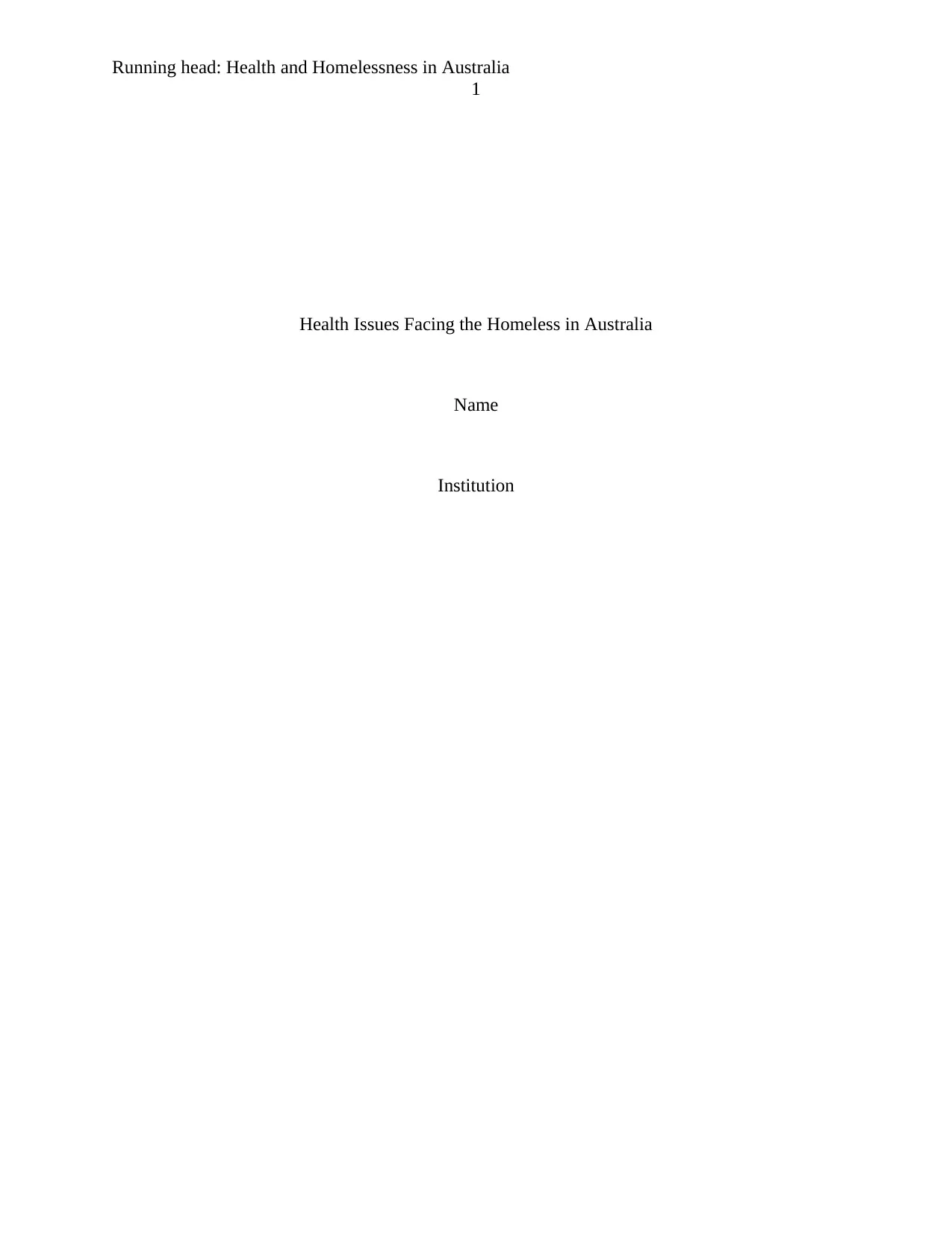
Running head: Health and Homelessness in Australia
1
Health Issues Facing the Homeless in Australia
Name
Institution
1
Health Issues Facing the Homeless in Australia
Name
Institution
Paraphrase This Document
Need a fresh take? Get an instant paraphrase of this document with our AI Paraphraser
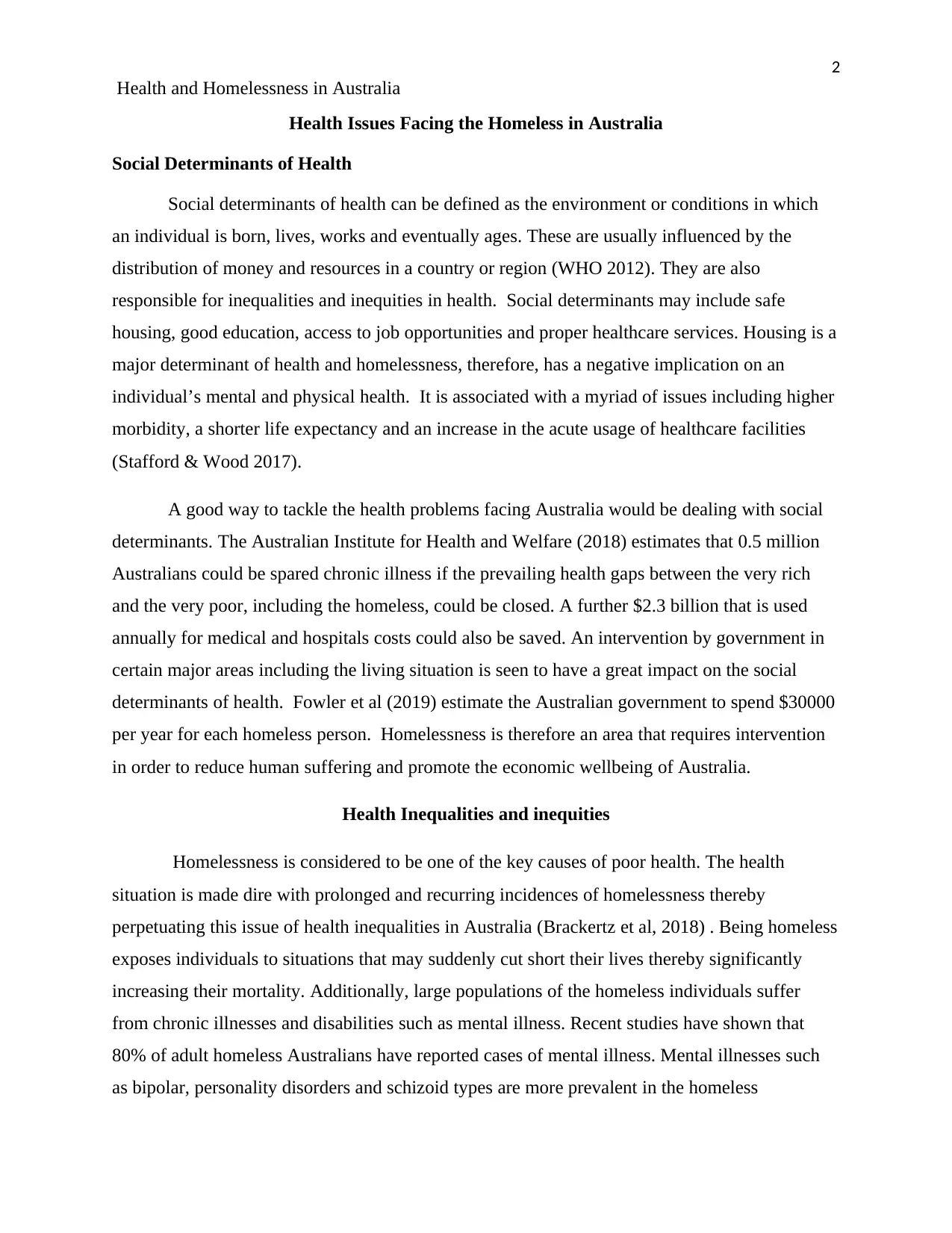
2
Health and Homelessness in Australia
Health Issues Facing the Homeless in Australia
Social Determinants of Health
Social determinants of health can be defined as the environment or conditions in which
an individual is born, lives, works and eventually ages. These are usually influenced by the
distribution of money and resources in a country or region (WHO 2012). They are also
responsible for inequalities and inequities in health. Social determinants may include safe
housing, good education, access to job opportunities and proper healthcare services. Housing is a
major determinant of health and homelessness, therefore, has a negative implication on an
individual’s mental and physical health. It is associated with a myriad of issues including higher
morbidity, a shorter life expectancy and an increase in the acute usage of healthcare facilities
(Stafford & Wood 2017).
A good way to tackle the health problems facing Australia would be dealing with social
determinants. The Australian Institute for Health and Welfare (2018) estimates that 0.5 million
Australians could be spared chronic illness if the prevailing health gaps between the very rich
and the very poor, including the homeless, could be closed. A further $2.3 billion that is used
annually for medical and hospitals costs could also be saved. An intervention by government in
certain major areas including the living situation is seen to have a great impact on the social
determinants of health. Fowler et al (2019) estimate the Australian government to spend $30000
per year for each homeless person. Homelessness is therefore an area that requires intervention
in order to reduce human suffering and promote the economic wellbeing of Australia.
Health Inequalities and inequities
Homelessness is considered to be one of the key causes of poor health. The health
situation is made dire with prolonged and recurring incidences of homelessness thereby
perpetuating this issue of health inequalities in Australia (Brackertz et al, 2018) . Being homeless
exposes individuals to situations that may suddenly cut short their lives thereby significantly
increasing their mortality. Additionally, large populations of the homeless individuals suffer
from chronic illnesses and disabilities such as mental illness. Recent studies have shown that
80% of adult homeless Australians have reported cases of mental illness. Mental illnesses such
as bipolar, personality disorders and schizoid types are more prevalent in the homeless
Health and Homelessness in Australia
Health Issues Facing the Homeless in Australia
Social Determinants of Health
Social determinants of health can be defined as the environment or conditions in which
an individual is born, lives, works and eventually ages. These are usually influenced by the
distribution of money and resources in a country or region (WHO 2012). They are also
responsible for inequalities and inequities in health. Social determinants may include safe
housing, good education, access to job opportunities and proper healthcare services. Housing is a
major determinant of health and homelessness, therefore, has a negative implication on an
individual’s mental and physical health. It is associated with a myriad of issues including higher
morbidity, a shorter life expectancy and an increase in the acute usage of healthcare facilities
(Stafford & Wood 2017).
A good way to tackle the health problems facing Australia would be dealing with social
determinants. The Australian Institute for Health and Welfare (2018) estimates that 0.5 million
Australians could be spared chronic illness if the prevailing health gaps between the very rich
and the very poor, including the homeless, could be closed. A further $2.3 billion that is used
annually for medical and hospitals costs could also be saved. An intervention by government in
certain major areas including the living situation is seen to have a great impact on the social
determinants of health. Fowler et al (2019) estimate the Australian government to spend $30000
per year for each homeless person. Homelessness is therefore an area that requires intervention
in order to reduce human suffering and promote the economic wellbeing of Australia.
Health Inequalities and inequities
Homelessness is considered to be one of the key causes of poor health. The health
situation is made dire with prolonged and recurring incidences of homelessness thereby
perpetuating this issue of health inequalities in Australia (Brackertz et al, 2018) . Being homeless
exposes individuals to situations that may suddenly cut short their lives thereby significantly
increasing their mortality. Additionally, large populations of the homeless individuals suffer
from chronic illnesses and disabilities such as mental illness. Recent studies have shown that
80% of adult homeless Australians have reported cases of mental illness. Mental illnesses such
as bipolar, personality disorders and schizoid types are more prevalent in the homeless
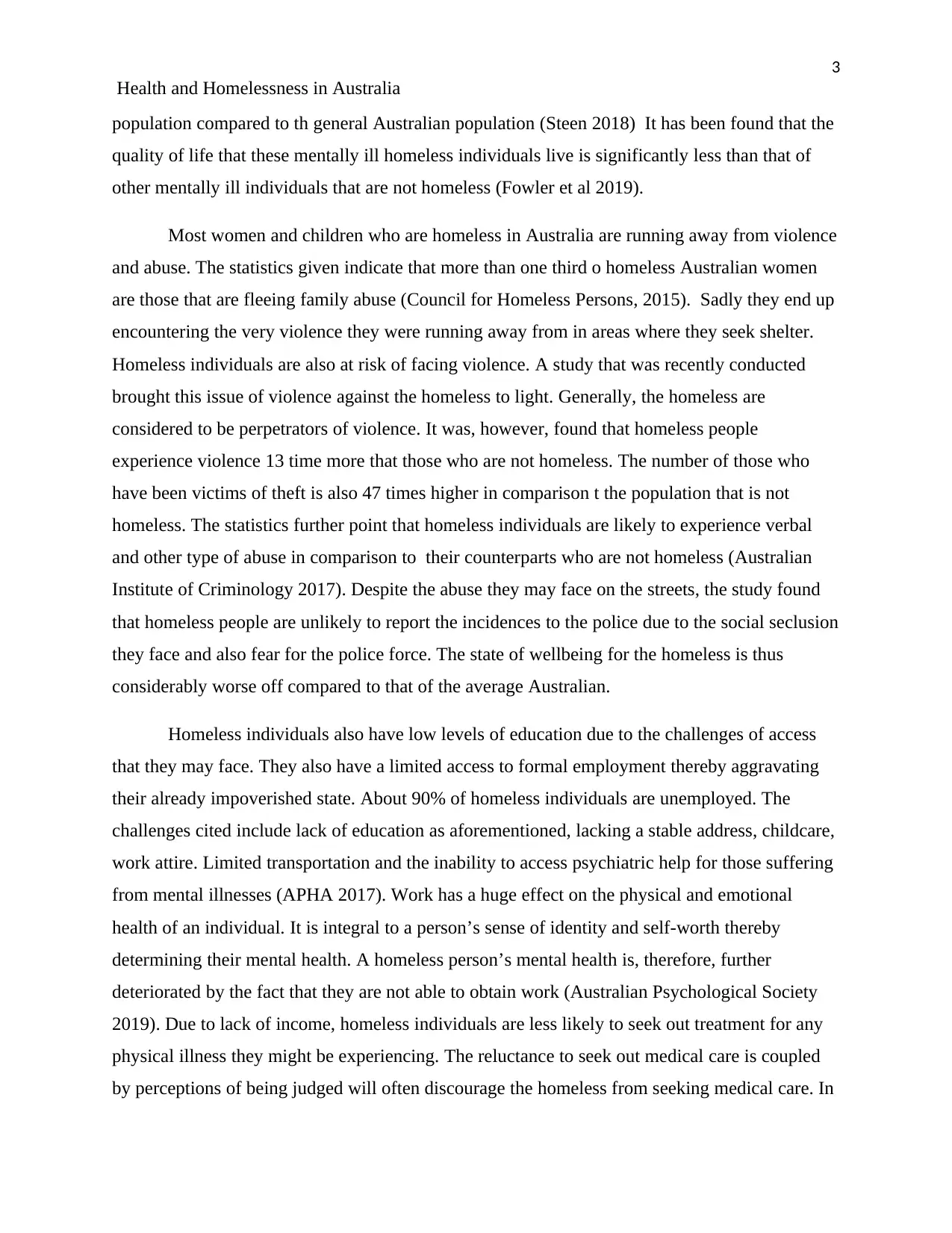
3
Health and Homelessness in Australia
population compared to th general Australian population (Steen 2018) It has been found that the
quality of life that these mentally ill homeless individuals live is significantly less than that of
other mentally ill individuals that are not homeless (Fowler et al 2019).
Most women and children who are homeless in Australia are running away from violence
and abuse. The statistics given indicate that more than one third o homeless Australian women
are those that are fleeing family abuse (Council for Homeless Persons, 2015). Sadly they end up
encountering the very violence they were running away from in areas where they seek shelter.
Homeless individuals are also at risk of facing violence. A study that was recently conducted
brought this issue of violence against the homeless to light. Generally, the homeless are
considered to be perpetrators of violence. It was, however, found that homeless people
experience violence 13 time more that those who are not homeless. The number of those who
have been victims of theft is also 47 times higher in comparison t the population that is not
homeless. The statistics further point that homeless individuals are likely to experience verbal
and other type of abuse in comparison to their counterparts who are not homeless (Australian
Institute of Criminology 2017). Despite the abuse they may face on the streets, the study found
that homeless people are unlikely to report the incidences to the police due to the social seclusion
they face and also fear for the police force. The state of wellbeing for the homeless is thus
considerably worse off compared to that of the average Australian.
Homeless individuals also have low levels of education due to the challenges of access
that they may face. They also have a limited access to formal employment thereby aggravating
their already impoverished state. About 90% of homeless individuals are unemployed. The
challenges cited include lack of education as aforementioned, lacking a stable address, childcare,
work attire. Limited transportation and the inability to access psychiatric help for those suffering
from mental illnesses (APHA 2017). Work has a huge effect on the physical and emotional
health of an individual. It is integral to a person’s sense of identity and self-worth thereby
determining their mental health. A homeless person’s mental health is, therefore, further
deteriorated by the fact that they are not able to obtain work (Australian Psychological Society
2019). Due to lack of income, homeless individuals are less likely to seek out treatment for any
physical illness they might be experiencing. The reluctance to seek out medical care is coupled
by perceptions of being judged will often discourage the homeless from seeking medical care. In
Health and Homelessness in Australia
population compared to th general Australian population (Steen 2018) It has been found that the
quality of life that these mentally ill homeless individuals live is significantly less than that of
other mentally ill individuals that are not homeless (Fowler et al 2019).
Most women and children who are homeless in Australia are running away from violence
and abuse. The statistics given indicate that more than one third o homeless Australian women
are those that are fleeing family abuse (Council for Homeless Persons, 2015). Sadly they end up
encountering the very violence they were running away from in areas where they seek shelter.
Homeless individuals are also at risk of facing violence. A study that was recently conducted
brought this issue of violence against the homeless to light. Generally, the homeless are
considered to be perpetrators of violence. It was, however, found that homeless people
experience violence 13 time more that those who are not homeless. The number of those who
have been victims of theft is also 47 times higher in comparison t the population that is not
homeless. The statistics further point that homeless individuals are likely to experience verbal
and other type of abuse in comparison to their counterparts who are not homeless (Australian
Institute of Criminology 2017). Despite the abuse they may face on the streets, the study found
that homeless people are unlikely to report the incidences to the police due to the social seclusion
they face and also fear for the police force. The state of wellbeing for the homeless is thus
considerably worse off compared to that of the average Australian.
Homeless individuals also have low levels of education due to the challenges of access
that they may face. They also have a limited access to formal employment thereby aggravating
their already impoverished state. About 90% of homeless individuals are unemployed. The
challenges cited include lack of education as aforementioned, lacking a stable address, childcare,
work attire. Limited transportation and the inability to access psychiatric help for those suffering
from mental illnesses (APHA 2017). Work has a huge effect on the physical and emotional
health of an individual. It is integral to a person’s sense of identity and self-worth thereby
determining their mental health. A homeless person’s mental health is, therefore, further
deteriorated by the fact that they are not able to obtain work (Australian Psychological Society
2019). Due to lack of income, homeless individuals are less likely to seek out treatment for any
physical illness they might be experiencing. The reluctance to seek out medical care is coupled
by perceptions of being judged will often discourage the homeless from seeking medical care. In
⊘ This is a preview!⊘
Do you want full access?
Subscribe today to unlock all pages.

Trusted by 1+ million students worldwide
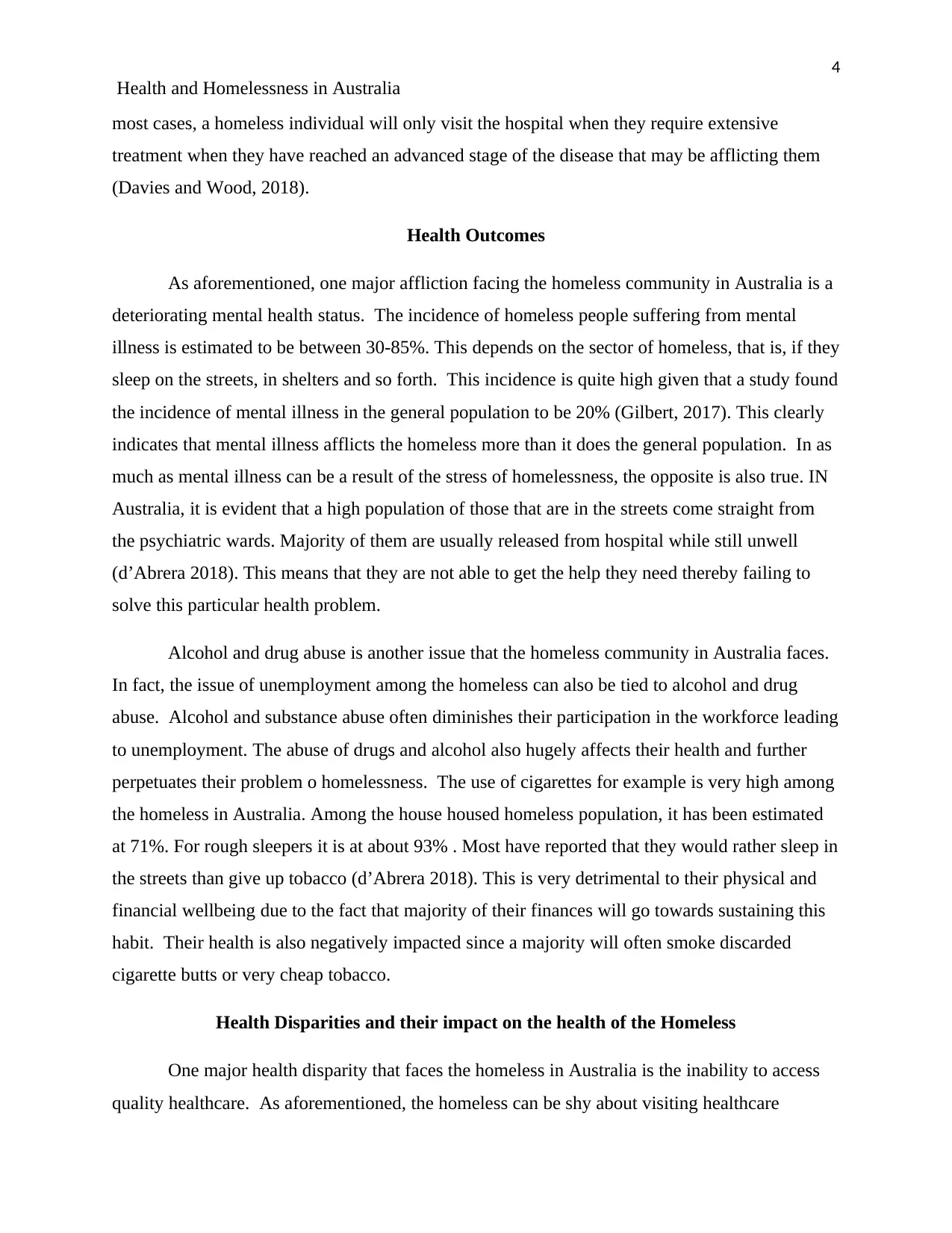
4
Health and Homelessness in Australia
most cases, a homeless individual will only visit the hospital when they require extensive
treatment when they have reached an advanced stage of the disease that may be afflicting them
(Davies and Wood, 2018).
Health Outcomes
As aforementioned, one major affliction facing the homeless community in Australia is a
deteriorating mental health status. The incidence of homeless people suffering from mental
illness is estimated to be between 30-85%. This depends on the sector of homeless, that is, if they
sleep on the streets, in shelters and so forth. This incidence is quite high given that a study found
the incidence of mental illness in the general population to be 20% (Gilbert, 2017). This clearly
indicates that mental illness afflicts the homeless more than it does the general population. In as
much as mental illness can be a result of the stress of homelessness, the opposite is also true. IN
Australia, it is evident that a high population of those that are in the streets come straight from
the psychiatric wards. Majority of them are usually released from hospital while still unwell
(d’Abrera 2018). This means that they are not able to get the help they need thereby failing to
solve this particular health problem.
Alcohol and drug abuse is another issue that the homeless community in Australia faces.
In fact, the issue of unemployment among the homeless can also be tied to alcohol and drug
abuse. Alcohol and substance abuse often diminishes their participation in the workforce leading
to unemployment. The abuse of drugs and alcohol also hugely affects their health and further
perpetuates their problem o homelessness. The use of cigarettes for example is very high among
the homeless in Australia. Among the house housed homeless population, it has been estimated
at 71%. For rough sleepers it is at about 93% . Most have reported that they would rather sleep in
the streets than give up tobacco (d’Abrera 2018). This is very detrimental to their physical and
financial wellbeing due to the fact that majority of their finances will go towards sustaining this
habit. Their health is also negatively impacted since a majority will often smoke discarded
cigarette butts or very cheap tobacco.
Health Disparities and their impact on the health of the Homeless
One major health disparity that faces the homeless in Australia is the inability to access
quality healthcare. As aforementioned, the homeless can be shy about visiting healthcare
Health and Homelessness in Australia
most cases, a homeless individual will only visit the hospital when they require extensive
treatment when they have reached an advanced stage of the disease that may be afflicting them
(Davies and Wood, 2018).
Health Outcomes
As aforementioned, one major affliction facing the homeless community in Australia is a
deteriorating mental health status. The incidence of homeless people suffering from mental
illness is estimated to be between 30-85%. This depends on the sector of homeless, that is, if they
sleep on the streets, in shelters and so forth. This incidence is quite high given that a study found
the incidence of mental illness in the general population to be 20% (Gilbert, 2017). This clearly
indicates that mental illness afflicts the homeless more than it does the general population. In as
much as mental illness can be a result of the stress of homelessness, the opposite is also true. IN
Australia, it is evident that a high population of those that are in the streets come straight from
the psychiatric wards. Majority of them are usually released from hospital while still unwell
(d’Abrera 2018). This means that they are not able to get the help they need thereby failing to
solve this particular health problem.
Alcohol and drug abuse is another issue that the homeless community in Australia faces.
In fact, the issue of unemployment among the homeless can also be tied to alcohol and drug
abuse. Alcohol and substance abuse often diminishes their participation in the workforce leading
to unemployment. The abuse of drugs and alcohol also hugely affects their health and further
perpetuates their problem o homelessness. The use of cigarettes for example is very high among
the homeless in Australia. Among the house housed homeless population, it has been estimated
at 71%. For rough sleepers it is at about 93% . Most have reported that they would rather sleep in
the streets than give up tobacco (d’Abrera 2018). This is very detrimental to their physical and
financial wellbeing due to the fact that majority of their finances will go towards sustaining this
habit. Their health is also negatively impacted since a majority will often smoke discarded
cigarette butts or very cheap tobacco.
Health Disparities and their impact on the health of the Homeless
One major health disparity that faces the homeless in Australia is the inability to access
quality healthcare. As aforementioned, the homeless can be shy about visiting healthcare
Paraphrase This Document
Need a fresh take? Get an instant paraphrase of this document with our AI Paraphraser
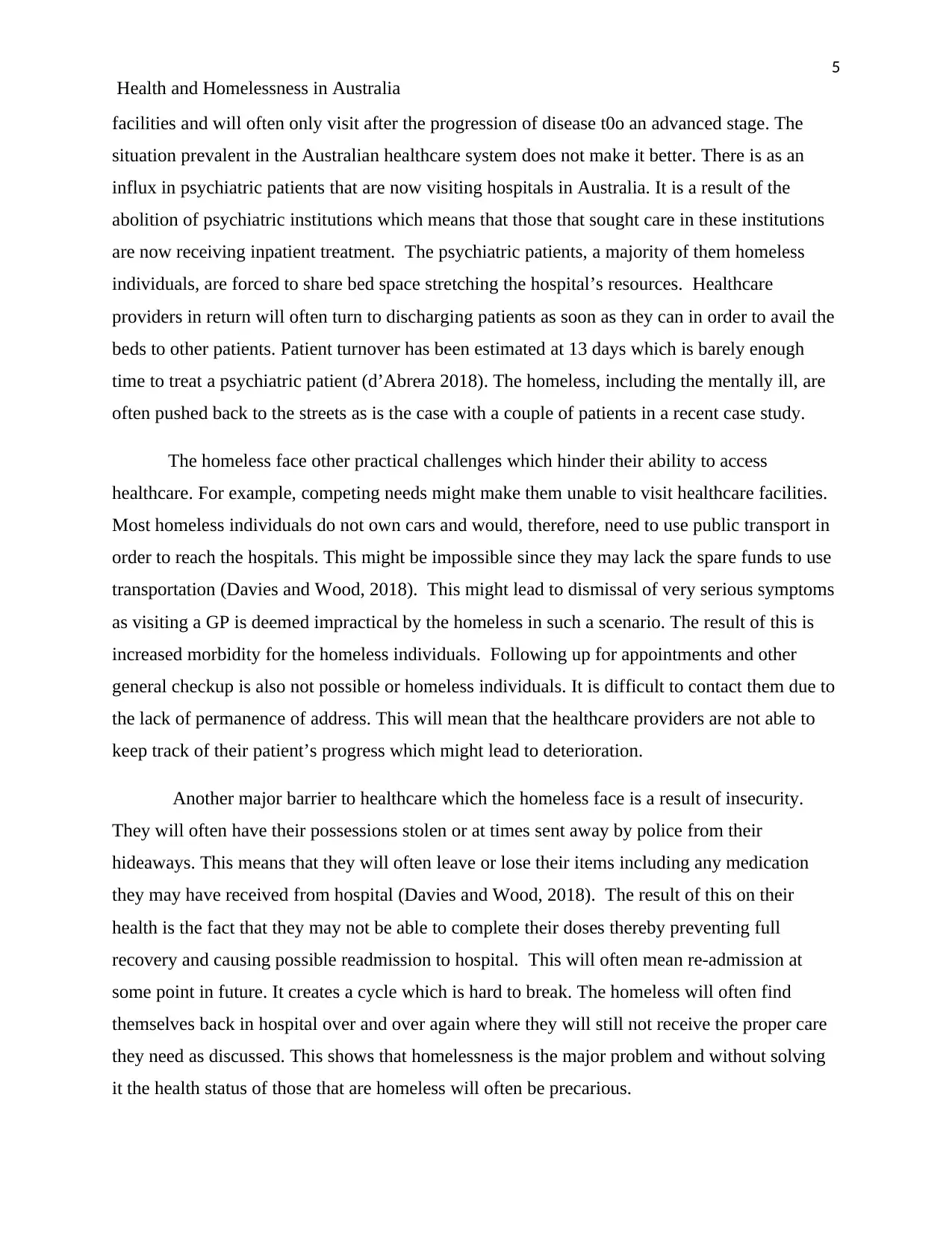
5
Health and Homelessness in Australia
facilities and will often only visit after the progression of disease t0o an advanced stage. The
situation prevalent in the Australian healthcare system does not make it better. There is as an
influx in psychiatric patients that are now visiting hospitals in Australia. It is a result of the
abolition of psychiatric institutions which means that those that sought care in these institutions
are now receiving inpatient treatment. The psychiatric patients, a majority of them homeless
individuals, are forced to share bed space stretching the hospital’s resources. Healthcare
providers in return will often turn to discharging patients as soon as they can in order to avail the
beds to other patients. Patient turnover has been estimated at 13 days which is barely enough
time to treat a psychiatric patient (d’Abrera 2018). The homeless, including the mentally ill, are
often pushed back to the streets as is the case with a couple of patients in a recent case study.
The homeless face other practical challenges which hinder their ability to access
healthcare. For example, competing needs might make them unable to visit healthcare facilities.
Most homeless individuals do not own cars and would, therefore, need to use public transport in
order to reach the hospitals. This might be impossible since they may lack the spare funds to use
transportation (Davies and Wood, 2018). This might lead to dismissal of very serious symptoms
as visiting a GP is deemed impractical by the homeless in such a scenario. The result of this is
increased morbidity for the homeless individuals. Following up for appointments and other
general checkup is also not possible or homeless individuals. It is difficult to contact them due to
the lack of permanence of address. This will mean that the healthcare providers are not able to
keep track of their patient’s progress which might lead to deterioration.
Another major barrier to healthcare which the homeless face is a result of insecurity.
They will often have their possessions stolen or at times sent away by police from their
hideaways. This means that they will often leave or lose their items including any medication
they may have received from hospital (Davies and Wood, 2018). The result of this on their
health is the fact that they may not be able to complete their doses thereby preventing full
recovery and causing possible readmission to hospital. This will often mean re-admission at
some point in future. It creates a cycle which is hard to break. The homeless will often find
themselves back in hospital over and over again where they will still not receive the proper care
they need as discussed. This shows that homelessness is the major problem and without solving
it the health status of those that are homeless will often be precarious.
Health and Homelessness in Australia
facilities and will often only visit after the progression of disease t0o an advanced stage. The
situation prevalent in the Australian healthcare system does not make it better. There is as an
influx in psychiatric patients that are now visiting hospitals in Australia. It is a result of the
abolition of psychiatric institutions which means that those that sought care in these institutions
are now receiving inpatient treatment. The psychiatric patients, a majority of them homeless
individuals, are forced to share bed space stretching the hospital’s resources. Healthcare
providers in return will often turn to discharging patients as soon as they can in order to avail the
beds to other patients. Patient turnover has been estimated at 13 days which is barely enough
time to treat a psychiatric patient (d’Abrera 2018). The homeless, including the mentally ill, are
often pushed back to the streets as is the case with a couple of patients in a recent case study.
The homeless face other practical challenges which hinder their ability to access
healthcare. For example, competing needs might make them unable to visit healthcare facilities.
Most homeless individuals do not own cars and would, therefore, need to use public transport in
order to reach the hospitals. This might be impossible since they may lack the spare funds to use
transportation (Davies and Wood, 2018). This might lead to dismissal of very serious symptoms
as visiting a GP is deemed impractical by the homeless in such a scenario. The result of this is
increased morbidity for the homeless individuals. Following up for appointments and other
general checkup is also not possible or homeless individuals. It is difficult to contact them due to
the lack of permanence of address. This will mean that the healthcare providers are not able to
keep track of their patient’s progress which might lead to deterioration.
Another major barrier to healthcare which the homeless face is a result of insecurity.
They will often have their possessions stolen or at times sent away by police from their
hideaways. This means that they will often leave or lose their items including any medication
they may have received from hospital (Davies and Wood, 2018). The result of this on their
health is the fact that they may not be able to complete their doses thereby preventing full
recovery and causing possible readmission to hospital. This will often mean re-admission at
some point in future. It creates a cycle which is hard to break. The homeless will often find
themselves back in hospital over and over again where they will still not receive the proper care
they need as discussed. This shows that homelessness is the major problem and without solving
it the health status of those that are homeless will often be precarious.
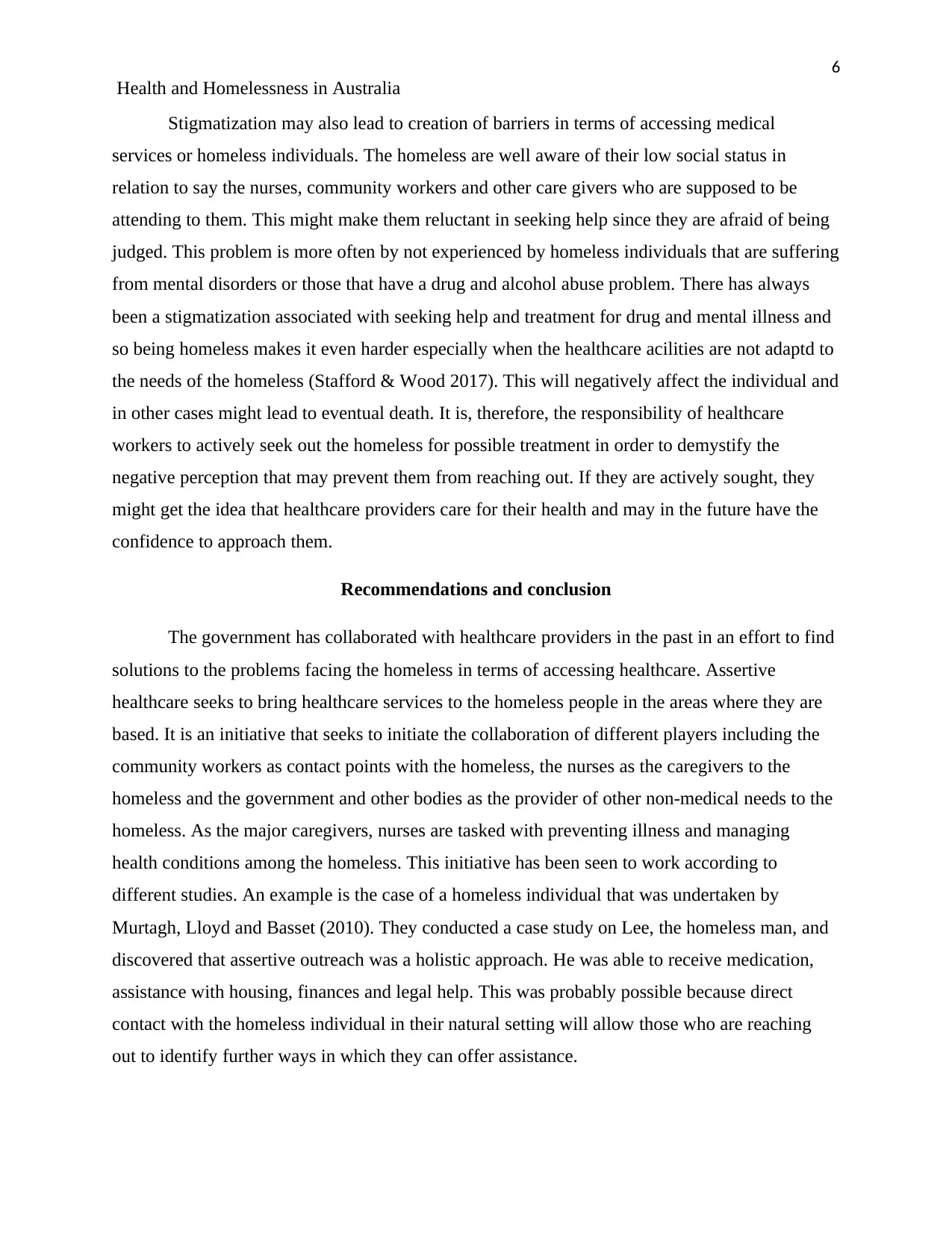
6
Health and Homelessness in Australia
Stigmatization may also lead to creation of barriers in terms of accessing medical
services or homeless individuals. The homeless are well aware of their low social status in
relation to say the nurses, community workers and other care givers who are supposed to be
attending to them. This might make them reluctant in seeking help since they are afraid of being
judged. This problem is more often by not experienced by homeless individuals that are suffering
from mental disorders or those that have a drug and alcohol abuse problem. There has always
been a stigmatization associated with seeking help and treatment for drug and mental illness and
so being homeless makes it even harder especially when the healthcare acilities are not adaptd to
the needs of the homeless (Stafford & Wood 2017). This will negatively affect the individual and
in other cases might lead to eventual death. It is, therefore, the responsibility of healthcare
workers to actively seek out the homeless for possible treatment in order to demystify the
negative perception that may prevent them from reaching out. If they are actively sought, they
might get the idea that healthcare providers care for their health and may in the future have the
confidence to approach them.
Recommendations and conclusion
The government has collaborated with healthcare providers in the past in an effort to find
solutions to the problems facing the homeless in terms of accessing healthcare. Assertive
healthcare seeks to bring healthcare services to the homeless people in the areas where they are
based. It is an initiative that seeks to initiate the collaboration of different players including the
community workers as contact points with the homeless, the nurses as the caregivers to the
homeless and the government and other bodies as the provider of other non-medical needs to the
homeless. As the major caregivers, nurses are tasked with preventing illness and managing
health conditions among the homeless. This initiative has been seen to work according to
different studies. An example is the case of a homeless individual that was undertaken by
Murtagh, Lloyd and Basset (2010). They conducted a case study on Lee, the homeless man, and
discovered that assertive outreach was a holistic approach. He was able to receive medication,
assistance with housing, finances and legal help. This was probably possible because direct
contact with the homeless individual in their natural setting will allow those who are reaching
out to identify further ways in which they can offer assistance.
Health and Homelessness in Australia
Stigmatization may also lead to creation of barriers in terms of accessing medical
services or homeless individuals. The homeless are well aware of their low social status in
relation to say the nurses, community workers and other care givers who are supposed to be
attending to them. This might make them reluctant in seeking help since they are afraid of being
judged. This problem is more often by not experienced by homeless individuals that are suffering
from mental disorders or those that have a drug and alcohol abuse problem. There has always
been a stigmatization associated with seeking help and treatment for drug and mental illness and
so being homeless makes it even harder especially when the healthcare acilities are not adaptd to
the needs of the homeless (Stafford & Wood 2017). This will negatively affect the individual and
in other cases might lead to eventual death. It is, therefore, the responsibility of healthcare
workers to actively seek out the homeless for possible treatment in order to demystify the
negative perception that may prevent them from reaching out. If they are actively sought, they
might get the idea that healthcare providers care for their health and may in the future have the
confidence to approach them.
Recommendations and conclusion
The government has collaborated with healthcare providers in the past in an effort to find
solutions to the problems facing the homeless in terms of accessing healthcare. Assertive
healthcare seeks to bring healthcare services to the homeless people in the areas where they are
based. It is an initiative that seeks to initiate the collaboration of different players including the
community workers as contact points with the homeless, the nurses as the caregivers to the
homeless and the government and other bodies as the provider of other non-medical needs to the
homeless. As the major caregivers, nurses are tasked with preventing illness and managing
health conditions among the homeless. This initiative has been seen to work according to
different studies. An example is the case of a homeless individual that was undertaken by
Murtagh, Lloyd and Basset (2010). They conducted a case study on Lee, the homeless man, and
discovered that assertive outreach was a holistic approach. He was able to receive medication,
assistance with housing, finances and legal help. This was probably possible because direct
contact with the homeless individual in their natural setting will allow those who are reaching
out to identify further ways in which they can offer assistance.
⊘ This is a preview!⊘
Do you want full access?
Subscribe today to unlock all pages.

Trusted by 1+ million students worldwide
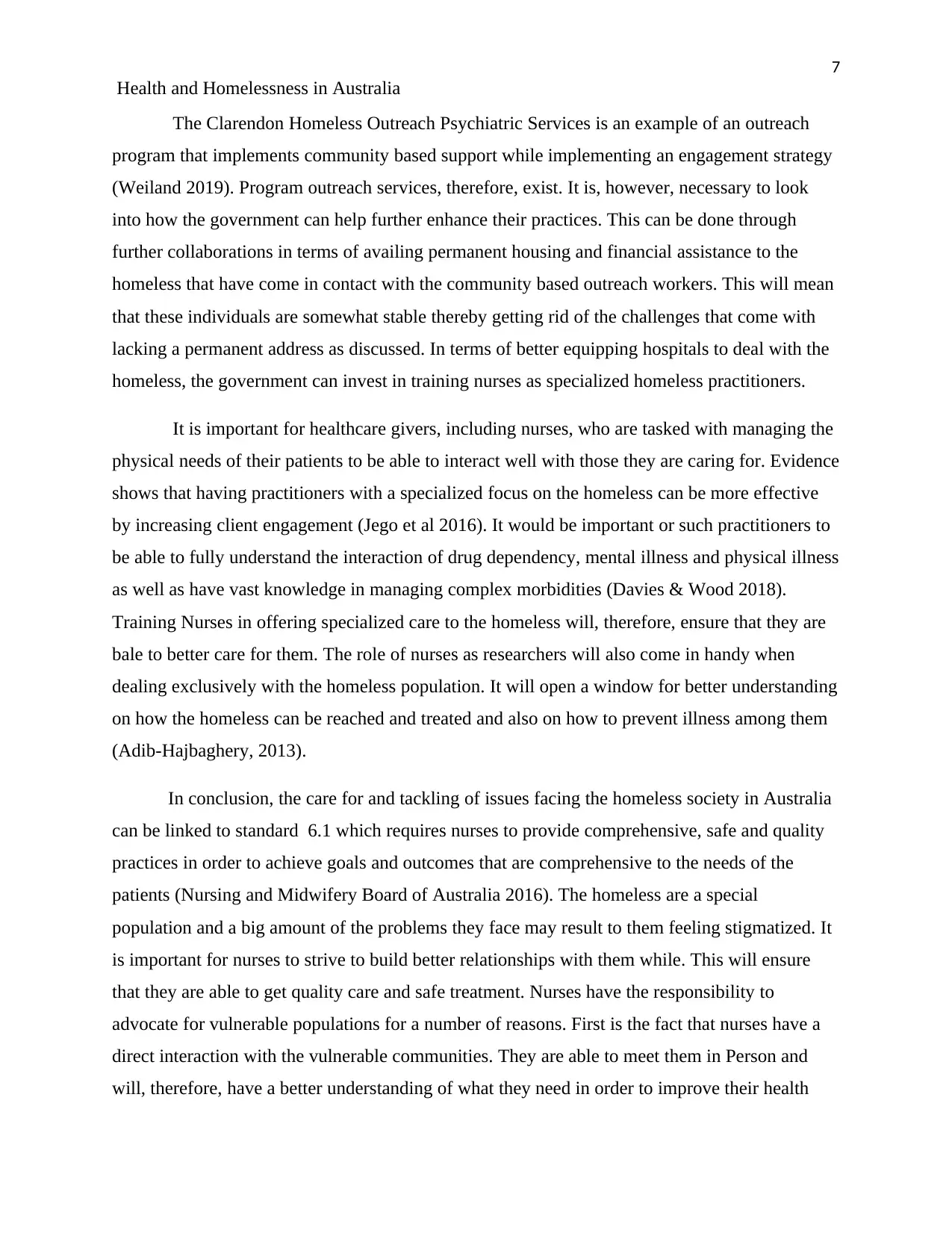
7
Health and Homelessness in Australia
The Clarendon Homeless Outreach Psychiatric Services is an example of an outreach
program that implements community based support while implementing an engagement strategy
(Weiland 2019). Program outreach services, therefore, exist. It is, however, necessary to look
into how the government can help further enhance their practices. This can be done through
further collaborations in terms of availing permanent housing and financial assistance to the
homeless that have come in contact with the community based outreach workers. This will mean
that these individuals are somewhat stable thereby getting rid of the challenges that come with
lacking a permanent address as discussed. In terms of better equipping hospitals to deal with the
homeless, the government can invest in training nurses as specialized homeless practitioners.
It is important for healthcare givers, including nurses, who are tasked with managing the
physical needs of their patients to be able to interact well with those they are caring for. Evidence
shows that having practitioners with a specialized focus on the homeless can be more effective
by increasing client engagement (Jego et al 2016). It would be important or such practitioners to
be able to fully understand the interaction of drug dependency, mental illness and physical illness
as well as have vast knowledge in managing complex morbidities (Davies & Wood 2018).
Training Nurses in offering specialized care to the homeless will, therefore, ensure that they are
bale to better care for them. The role of nurses as researchers will also come in handy when
dealing exclusively with the homeless population. It will open a window for better understanding
on how the homeless can be reached and treated and also on how to prevent illness among them
(Adib-Hajbaghery, 2013).
In conclusion, the care for and tackling of issues facing the homeless society in Australia
can be linked to standard 6.1 which requires nurses to provide comprehensive, safe and quality
practices in order to achieve goals and outcomes that are comprehensive to the needs of the
patients (Nursing and Midwifery Board of Australia 2016). The homeless are a special
population and a big amount of the problems they face may result to them feeling stigmatized. It
is important for nurses to strive to build better relationships with them while. This will ensure
that they are able to get quality care and safe treatment. Nurses have the responsibility to
advocate for vulnerable populations for a number of reasons. First is the fact that nurses have a
direct interaction with the vulnerable communities. They are able to meet them in Person and
will, therefore, have a better understanding of what they need in order to improve their health
Health and Homelessness in Australia
The Clarendon Homeless Outreach Psychiatric Services is an example of an outreach
program that implements community based support while implementing an engagement strategy
(Weiland 2019). Program outreach services, therefore, exist. It is, however, necessary to look
into how the government can help further enhance their practices. This can be done through
further collaborations in terms of availing permanent housing and financial assistance to the
homeless that have come in contact with the community based outreach workers. This will mean
that these individuals are somewhat stable thereby getting rid of the challenges that come with
lacking a permanent address as discussed. In terms of better equipping hospitals to deal with the
homeless, the government can invest in training nurses as specialized homeless practitioners.
It is important for healthcare givers, including nurses, who are tasked with managing the
physical needs of their patients to be able to interact well with those they are caring for. Evidence
shows that having practitioners with a specialized focus on the homeless can be more effective
by increasing client engagement (Jego et al 2016). It would be important or such practitioners to
be able to fully understand the interaction of drug dependency, mental illness and physical illness
as well as have vast knowledge in managing complex morbidities (Davies & Wood 2018).
Training Nurses in offering specialized care to the homeless will, therefore, ensure that they are
bale to better care for them. The role of nurses as researchers will also come in handy when
dealing exclusively with the homeless population. It will open a window for better understanding
on how the homeless can be reached and treated and also on how to prevent illness among them
(Adib-Hajbaghery, 2013).
In conclusion, the care for and tackling of issues facing the homeless society in Australia
can be linked to standard 6.1 which requires nurses to provide comprehensive, safe and quality
practices in order to achieve goals and outcomes that are comprehensive to the needs of the
patients (Nursing and Midwifery Board of Australia 2016). The homeless are a special
population and a big amount of the problems they face may result to them feeling stigmatized. It
is important for nurses to strive to build better relationships with them while. This will ensure
that they are able to get quality care and safe treatment. Nurses have the responsibility to
advocate for vulnerable populations for a number of reasons. First is the fact that nurses have a
direct interaction with the vulnerable communities. They are able to meet them in Person and
will, therefore, have a better understanding of what they need in order to improve their health
Paraphrase This Document
Need a fresh take? Get an instant paraphrase of this document with our AI Paraphraser
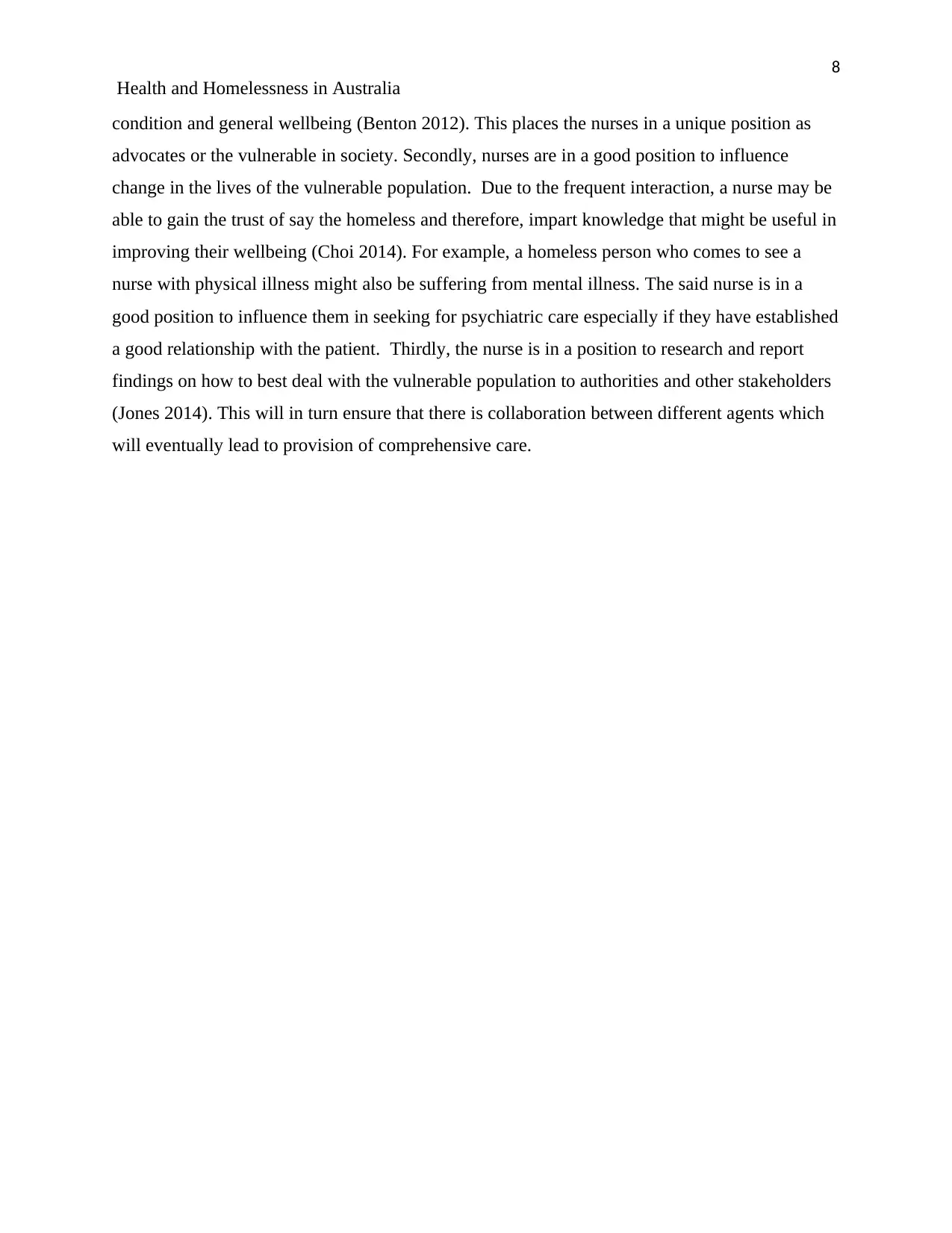
8
Health and Homelessness in Australia
condition and general wellbeing (Benton 2012). This places the nurses in a unique position as
advocates or the vulnerable in society. Secondly, nurses are in a good position to influence
change in the lives of the vulnerable population. Due to the frequent interaction, a nurse may be
able to gain the trust of say the homeless and therefore, impart knowledge that might be useful in
improving their wellbeing (Choi 2014). For example, a homeless person who comes to see a
nurse with physical illness might also be suffering from mental illness. The said nurse is in a
good position to influence them in seeking for psychiatric care especially if they have established
a good relationship with the patient. Thirdly, the nurse is in a position to research and report
findings on how to best deal with the vulnerable population to authorities and other stakeholders
(Jones 2014). This will in turn ensure that there is collaboration between different agents which
will eventually lead to provision of comprehensive care.
Health and Homelessness in Australia
condition and general wellbeing (Benton 2012). This places the nurses in a unique position as
advocates or the vulnerable in society. Secondly, nurses are in a good position to influence
change in the lives of the vulnerable population. Due to the frequent interaction, a nurse may be
able to gain the trust of say the homeless and therefore, impart knowledge that might be useful in
improving their wellbeing (Choi 2014). For example, a homeless person who comes to see a
nurse with physical illness might also be suffering from mental illness. The said nurse is in a
good position to influence them in seeking for psychiatric care especially if they have established
a good relationship with the patient. Thirdly, the nurse is in a position to research and report
findings on how to best deal with the vulnerable population to authorities and other stakeholders
(Jones 2014). This will in turn ensure that there is collaboration between different agents which
will eventually lead to provision of comprehensive care.
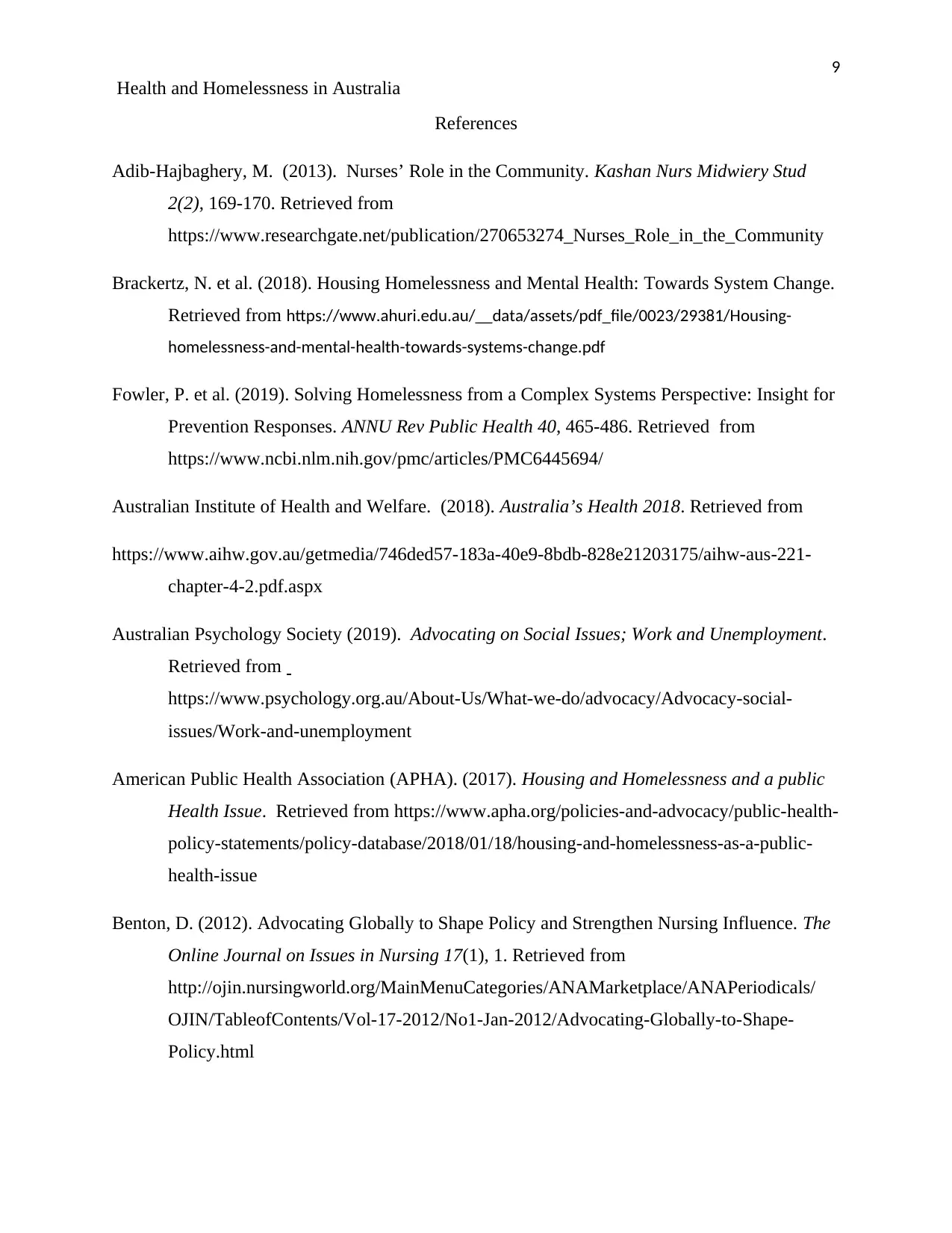
9
Health and Homelessness in Australia
References
Adib-Hajbaghery, M. (2013). Nurses’ Role in the Community. Kashan Nurs Midwiery Stud
2(2), 169-170. Retrieved from
https://www.researchgate.net/publication/270653274_Nurses_Role_in_the_Community
Brackertz, N. et al. (2018). Housing Homelessness and Mental Health: Towards System Change.
Retrieved from https://www.ahuri.edu.au/__data/assets/pdf_file/0023/29381/Housing-
homelessness-and-mental-health-towards-systems-change.pdf
Fowler, P. et al. (2019). Solving Homelessness from a Complex Systems Perspective: Insight for
Prevention Responses. ANNU Rev Public Health 40, 465-486. Retrieved from
https://www.ncbi.nlm.nih.gov/pmc/articles/PMC6445694/
Australian Institute of Health and Welfare. (2018). Australia’s Health 2018. Retrieved from
https://www.aihw.gov.au/getmedia/746ded57-183a-40e9-8bdb-828e21203175/aihw-aus-221-
chapter-4-2.pdf.aspx
Australian Psychology Society (2019). Advocating on Social Issues; Work and Unemployment.
Retrieved from
https://www.psychology.org.au/About-Us/What-we-do/advocacy/Advocacy-social-
issues/Work-and-unemployment
American Public Health Association (APHA). (2017). Housing and Homelessness and a public
Health Issue. Retrieved from https://www.apha.org/policies-and-advocacy/public-health-
policy-statements/policy-database/2018/01/18/housing-and-homelessness-as-a-public-
health-issue
Benton, D. (2012). Advocating Globally to Shape Policy and Strengthen Nursing Influence. The
Online Journal on Issues in Nursing 17(1), 1. Retrieved from
http://ojin.nursingworld.org/MainMenuCategories/ANAMarketplace/ANAPeriodicals/
OJIN/TableofContents/Vol-17-2012/No1-Jan-2012/Advocating-Globally-to-Shape-
Policy.html
Health and Homelessness in Australia
References
Adib-Hajbaghery, M. (2013). Nurses’ Role in the Community. Kashan Nurs Midwiery Stud
2(2), 169-170. Retrieved from
https://www.researchgate.net/publication/270653274_Nurses_Role_in_the_Community
Brackertz, N. et al. (2018). Housing Homelessness and Mental Health: Towards System Change.
Retrieved from https://www.ahuri.edu.au/__data/assets/pdf_file/0023/29381/Housing-
homelessness-and-mental-health-towards-systems-change.pdf
Fowler, P. et al. (2019). Solving Homelessness from a Complex Systems Perspective: Insight for
Prevention Responses. ANNU Rev Public Health 40, 465-486. Retrieved from
https://www.ncbi.nlm.nih.gov/pmc/articles/PMC6445694/
Australian Institute of Health and Welfare. (2018). Australia’s Health 2018. Retrieved from
https://www.aihw.gov.au/getmedia/746ded57-183a-40e9-8bdb-828e21203175/aihw-aus-221-
chapter-4-2.pdf.aspx
Australian Psychology Society (2019). Advocating on Social Issues; Work and Unemployment.
Retrieved from
https://www.psychology.org.au/About-Us/What-we-do/advocacy/Advocacy-social-
issues/Work-and-unemployment
American Public Health Association (APHA). (2017). Housing and Homelessness and a public
Health Issue. Retrieved from https://www.apha.org/policies-and-advocacy/public-health-
policy-statements/policy-database/2018/01/18/housing-and-homelessness-as-a-public-
health-issue
Benton, D. (2012). Advocating Globally to Shape Policy and Strengthen Nursing Influence. The
Online Journal on Issues in Nursing 17(1), 1. Retrieved from
http://ojin.nursingworld.org/MainMenuCategories/ANAMarketplace/ANAPeriodicals/
OJIN/TableofContents/Vol-17-2012/No1-Jan-2012/Advocating-Globally-to-Shape-
Policy.html
⊘ This is a preview!⊘
Do you want full access?
Subscribe today to unlock all pages.

Trusted by 1+ million students worldwide
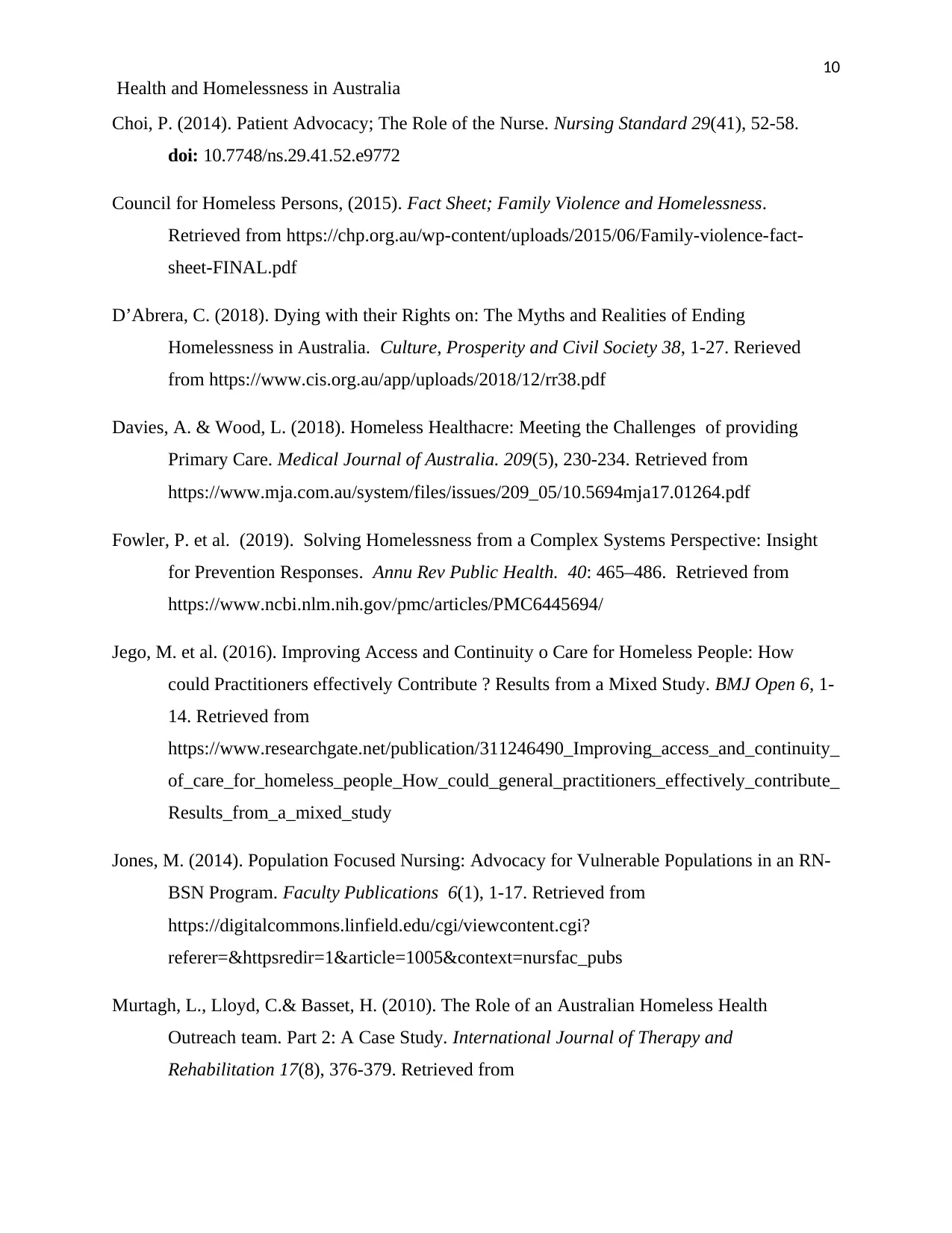
10
Health and Homelessness in Australia
Choi, P. (2014). Patient Advocacy; The Role of the Nurse. Nursing Standard 29(41), 52-58.
doi: 10.7748/ns.29.41.52.e9772
Council for Homeless Persons, (2015). Fact Sheet; Family Violence and Homelessness.
Retrieved from https://chp.org.au/wp-content/uploads/2015/06/Family-violence-fact-
sheet-FINAL.pdf
D’Abrera, C. (2018). Dying with their Rights on: The Myths and Realities of Ending
Homelessness in Australia. Culture, Prosperity and Civil Society 38, 1-27. Rerieved
from https://www.cis.org.au/app/uploads/2018/12/rr38.pdf
Davies, A. & Wood, L. (2018). Homeless Healthacre: Meeting the Challenges of providing
Primary Care. Medical Journal of Australia. 209(5), 230-234. Retrieved from
https://www.mja.com.au/system/files/issues/209_05/10.5694mja17.01264.pdf
Fowler, P. et al. (2019). Solving Homelessness from a Complex Systems Perspective: Insight
for Prevention Responses. Annu Rev Public Health. 40: 465–486. Retrieved from
https://www.ncbi.nlm.nih.gov/pmc/articles/PMC6445694/
Jego, M. et al. (2016). Improving Access and Continuity o Care for Homeless People: How
could Practitioners effectively Contribute ? Results from a Mixed Study. BMJ Open 6, 1-
14. Retrieved from
https://www.researchgate.net/publication/311246490_Improving_access_and_continuity_
of_care_for_homeless_people_How_could_general_practitioners_effectively_contribute_
Results_from_a_mixed_study
Jones, M. (2014). Population Focused Nursing: Advocacy for Vulnerable Populations in an RN-
BSN Program. Faculty Publications 6(1), 1-17. Retrieved from
https://digitalcommons.linfield.edu/cgi/viewcontent.cgi?
referer=&httpsredir=1&article=1005&context=nursfac_pubs
Murtagh, L., Lloyd, C.& Basset, H. (2010). The Role of an Australian Homeless Health
Outreach team. Part 2: A Case Study. International Journal of Therapy and
Rehabilitation 17(8), 376-379. Retrieved from
Health and Homelessness in Australia
Choi, P. (2014). Patient Advocacy; The Role of the Nurse. Nursing Standard 29(41), 52-58.
doi: 10.7748/ns.29.41.52.e9772
Council for Homeless Persons, (2015). Fact Sheet; Family Violence and Homelessness.
Retrieved from https://chp.org.au/wp-content/uploads/2015/06/Family-violence-fact-
sheet-FINAL.pdf
D’Abrera, C. (2018). Dying with their Rights on: The Myths and Realities of Ending
Homelessness in Australia. Culture, Prosperity and Civil Society 38, 1-27. Rerieved
from https://www.cis.org.au/app/uploads/2018/12/rr38.pdf
Davies, A. & Wood, L. (2018). Homeless Healthacre: Meeting the Challenges of providing
Primary Care. Medical Journal of Australia. 209(5), 230-234. Retrieved from
https://www.mja.com.au/system/files/issues/209_05/10.5694mja17.01264.pdf
Fowler, P. et al. (2019). Solving Homelessness from a Complex Systems Perspective: Insight
for Prevention Responses. Annu Rev Public Health. 40: 465–486. Retrieved from
https://www.ncbi.nlm.nih.gov/pmc/articles/PMC6445694/
Jego, M. et al. (2016). Improving Access and Continuity o Care for Homeless People: How
could Practitioners effectively Contribute ? Results from a Mixed Study. BMJ Open 6, 1-
14. Retrieved from
https://www.researchgate.net/publication/311246490_Improving_access_and_continuity_
of_care_for_homeless_people_How_could_general_practitioners_effectively_contribute_
Results_from_a_mixed_study
Jones, M. (2014). Population Focused Nursing: Advocacy for Vulnerable Populations in an RN-
BSN Program. Faculty Publications 6(1), 1-17. Retrieved from
https://digitalcommons.linfield.edu/cgi/viewcontent.cgi?
referer=&httpsredir=1&article=1005&context=nursfac_pubs
Murtagh, L., Lloyd, C.& Basset, H. (2010). The Role of an Australian Homeless Health
Outreach team. Part 2: A Case Study. International Journal of Therapy and
Rehabilitation 17(8), 376-379. Retrieved from
Paraphrase This Document
Need a fresh take? Get an instant paraphrase of this document with our AI Paraphraser
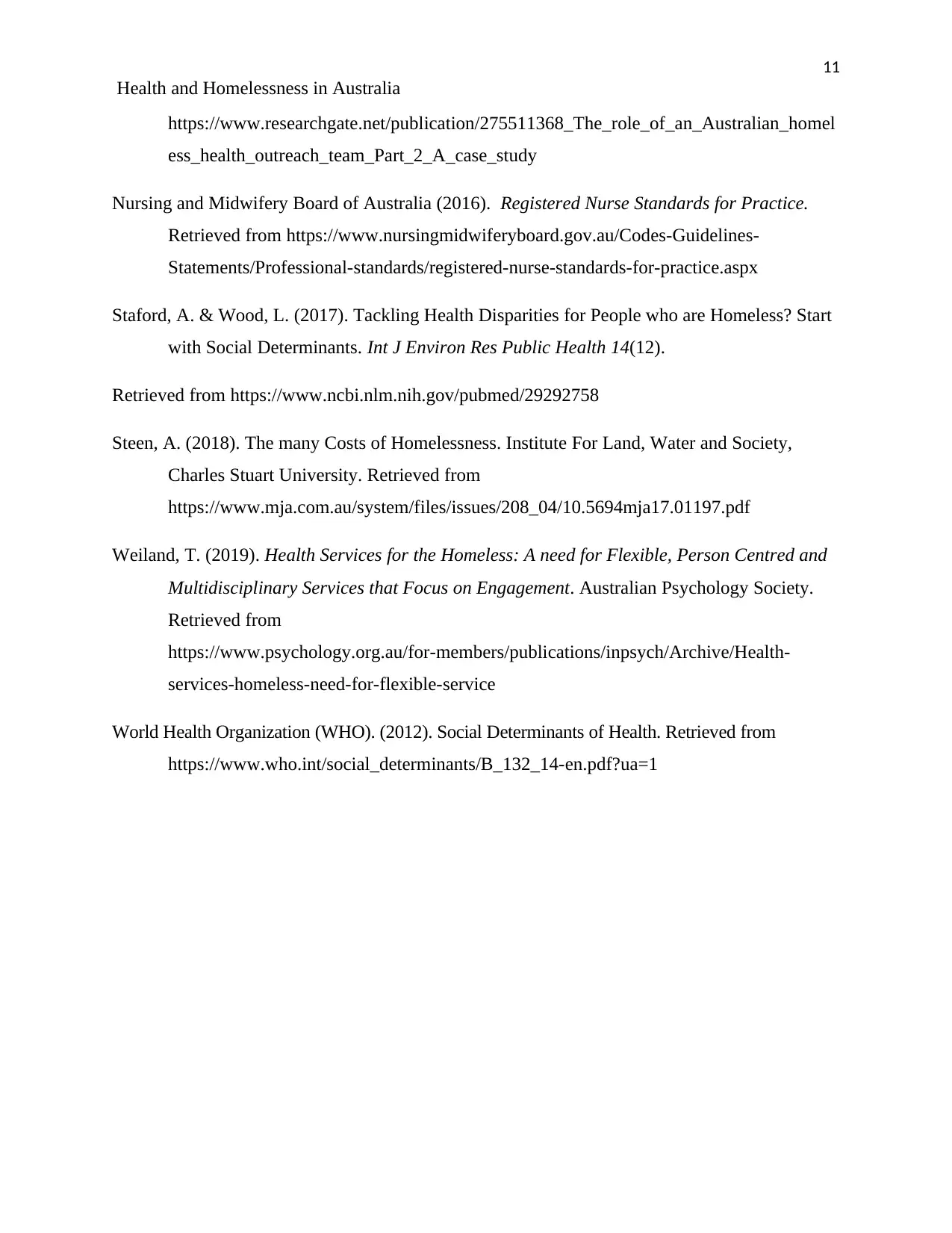
11
Health and Homelessness in Australia
https://www.researchgate.net/publication/275511368_The_role_of_an_Australian_homel
ess_health_outreach_team_Part_2_A_case_study
Nursing and Midwifery Board of Australia (2016). Registered Nurse Standards for Practice.
Retrieved from https://www.nursingmidwiferyboard.gov.au/Codes-Guidelines-
Statements/Professional-standards/registered-nurse-standards-for-practice.aspx
Staford, A. & Wood, L. (2017). Tackling Health Disparities for People who are Homeless? Start
with Social Determinants. Int J Environ Res Public Health 14(12).
Retrieved from https://www.ncbi.nlm.nih.gov/pubmed/29292758
Steen, A. (2018). The many Costs of Homelessness. Institute For Land, Water and Society,
Charles Stuart University. Retrieved from
https://www.mja.com.au/system/files/issues/208_04/10.5694mja17.01197.pdf
Weiland, T. (2019). Health Services for the Homeless: A need for Flexible, Person Centred and
Multidisciplinary Services that Focus on Engagement. Australian Psychology Society.
Retrieved from
https://www.psychology.org.au/for-members/publications/inpsych/Archive/Health-
services-homeless-need-for-flexible-service
World Health Organization (WHO). (2012). Social Determinants of Health. Retrieved from
https://www.who.int/social_determinants/B_132_14-en.pdf?ua=1
Health and Homelessness in Australia
https://www.researchgate.net/publication/275511368_The_role_of_an_Australian_homel
ess_health_outreach_team_Part_2_A_case_study
Nursing and Midwifery Board of Australia (2016). Registered Nurse Standards for Practice.
Retrieved from https://www.nursingmidwiferyboard.gov.au/Codes-Guidelines-
Statements/Professional-standards/registered-nurse-standards-for-practice.aspx
Staford, A. & Wood, L. (2017). Tackling Health Disparities for People who are Homeless? Start
with Social Determinants. Int J Environ Res Public Health 14(12).
Retrieved from https://www.ncbi.nlm.nih.gov/pubmed/29292758
Steen, A. (2018). The many Costs of Homelessness. Institute For Land, Water and Society,
Charles Stuart University. Retrieved from
https://www.mja.com.au/system/files/issues/208_04/10.5694mja17.01197.pdf
Weiland, T. (2019). Health Services for the Homeless: A need for Flexible, Person Centred and
Multidisciplinary Services that Focus on Engagement. Australian Psychology Society.
Retrieved from
https://www.psychology.org.au/for-members/publications/inpsych/Archive/Health-
services-homeless-need-for-flexible-service
World Health Organization (WHO). (2012). Social Determinants of Health. Retrieved from
https://www.who.int/social_determinants/B_132_14-en.pdf?ua=1
1 out of 11
Related Documents
Your All-in-One AI-Powered Toolkit for Academic Success.
+13062052269
info@desklib.com
Available 24*7 on WhatsApp / Email
![[object Object]](/_next/static/media/star-bottom.7253800d.svg)
Unlock your academic potential
Copyright © 2020–2025 A2Z Services. All Rights Reserved. Developed and managed by ZUCOL.





